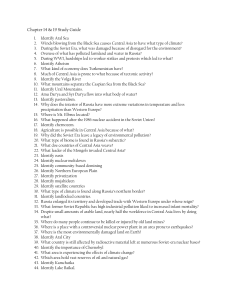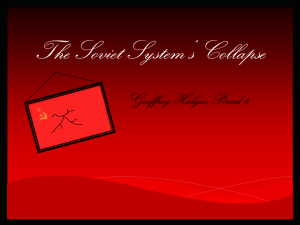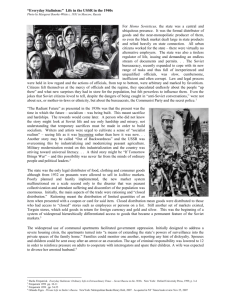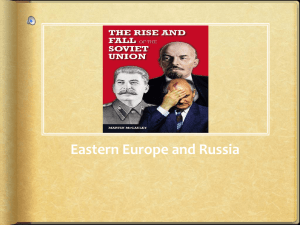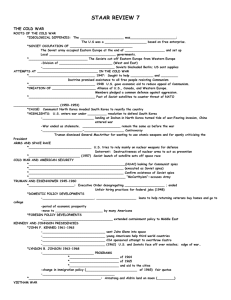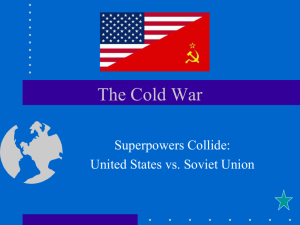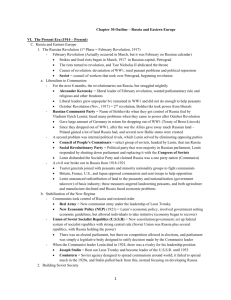Cold War and Modern Europe Study Guide
advertisement
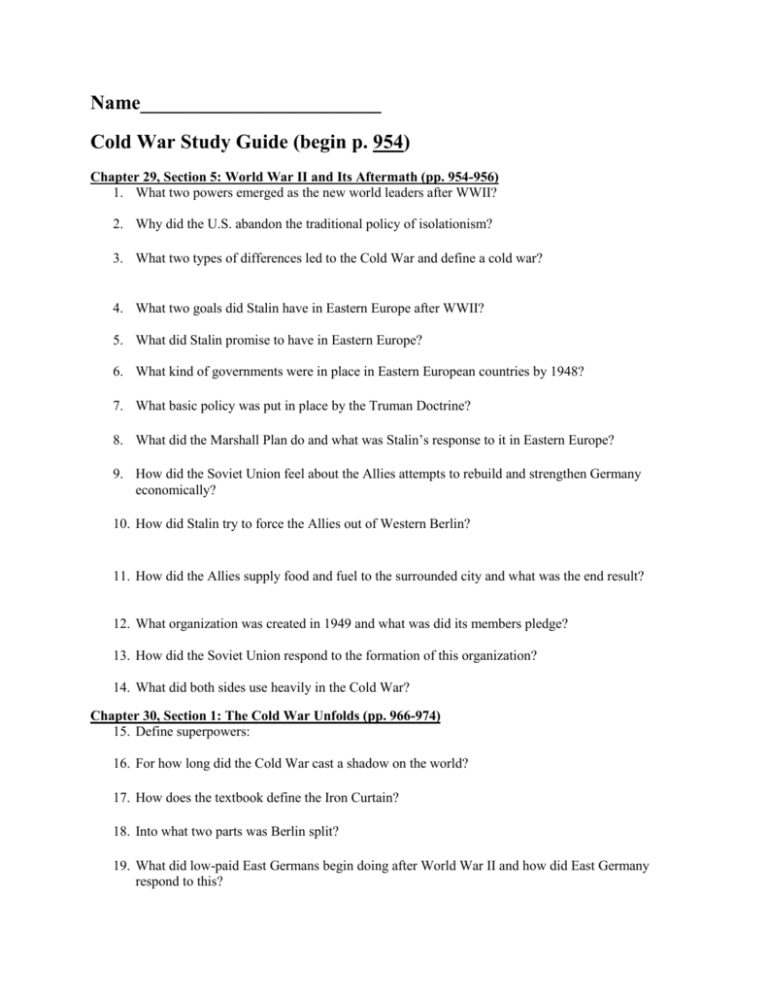
Name________________________ Cold War Study Guide (begin p. 954) Chapter 29, Section 5: World War II and Its Aftermath (pp. 954-956) 1. What two powers emerged as the new world leaders after WWII? 2. Why did the U.S. abandon the traditional policy of isolationism? 3. What two types of differences led to the Cold War and define a cold war? 4. What two goals did Stalin have in Eastern Europe after WWII? 5. What did Stalin promise to have in Eastern Europe? 6. What kind of governments were in place in Eastern European countries by 1948? 7. What basic policy was put in place by the Truman Doctrine? 8. What did the Marshall Plan do and what was Stalin’s response to it in Eastern Europe? 9. How did the Soviet Union feel about the Allies attempts to rebuild and strengthen Germany economically? 10. How did Stalin try to force the Allies out of Western Berlin? 11. How did the Allies supply food and fuel to the surrounded city and what was the end result? 12. What organization was created in 1949 and what was did its members pledge? 13. How did the Soviet Union respond to the formation of this organization? 14. What did both sides use heavily in the Cold War? Chapter 30, Section 1: The Cold War Unfolds (pp. 966-974) 15. Define superpowers: 16. For how long did the Cold War cast a shadow on the world? 17. How does the textbook define the Iron Curtain? 18. Into what two parts was Berlin split? 19. What did low-paid East Germans begin doing after World War II and how did East Germany respond to this? 20. What did the existence of this wall show the world? 21. Where did uprisings take place in Eastern Europe against Soviet domination? Why weren’t these ultimately successful? 22. What were Poles responding to in their uprisings in 1956? 23. What daring thing did Imre Nagy do in defiance of the Soviet Union and how did the Soviets respond to this challenge? 24. What was a blossoming of freedom of expression called in 1968 in Czechoslovakia and again how did the Warsaw Pact respond? 25. What had the Soviets developed by 1949, which shocked the U.S.? 26. What new weapon had both sides developed by 1953? 27. Why did both sides keep developing and building nuclear weapons in the face of mutual destruction? 28. What did both sides agree to do in order to reduce the threat of a nuclear war? 29. What were nuclear weapon talks between the U.S. and Soviet Union called? 30. What type of weapon was seen as particularly threatening to the peace by both sides in the Cold War? 31. What new program did Ronald Reagan launch in the 1980s and what agreement was signed in 1991? 32. Define détante: 33. What event ended the era of détante in 1979? 34. What other countries had developed nuclear weapons by the late 1960s and what treaty was signed to limit the spread of nuclear weapons to other countries? 35. What began to happen with the Cold War after World War II and what did the U.S. do in response? 36. What did the Americans establish all over the world to help stop or be prepared for the spread of communism? 37. What did groups battling European countries for independence and an end to colonialism often do during the Cold War period? 38. In what two places did the Cold War become a shooting war in the world? 39. Where did the most threatening Cold War conflict happen very near to the U.S.? 40. What policies did Stalin continue after the end of World War II until his death in 1953? 41. Define ideology: 42. Who/What makes decisions in most command economies and what is the net result of this? 43. What did Nikita Khrushchev say which shocked Communist Party members, what did he do regarding prison camps and censorship, and what did he call for with the West? 44. What types of political methods did Leonid Brezhnev return to? 45. List two Russian individuals who stood up to Soviet tyranny during the Cold War. 46. How does a market economy differ from a command economy? 47. Define containment: 48. What are fallout shelters and what were they stocked with? Chapter 30, Section 2: The Industrialized Democracies (SKIP TO PAGE 980-983!!!!!) 49. What happened more rapidly than anyone had predicted in Western Europe? 50. What stark difference could be seen between East and West Germany during the Cold War? 51. What happened quickly after the decline of communism in Germany in 1989? 52. What did Konrad Adenauer guide in West Germany and what did West Germany create despite high taxes to pay for the recovery? 53. What was slow to recover in Great Britain after the Cold War? 54. What did countries like Great Britain, France, Belgium and Holland lose due to being weakened by World War II? 55. Despite these losses, what gradually improved in Western European countries after WWII? 56. Define welfare state and provide examples of how Western European governments took care of their citizens. 57. Who led opponents of the welfare state in Britain in 1979 and what impact did this have on other European nations? 58. What six nations set up the European Economic Community (EEC) in 1957 and what did it dedicate itself to? Chapter 30, Section 5: The End of the Cold War (pp. 1000-1006) 59. What did Soviets see a shift away from and toward during the rule of Krushchev? 60. What did the Soviet Union launch in 1957? 61. How did Soviet consumer goods compare to those of the West? 62. What made it impossible for the Soviets to compete long term against the U.S. in the arms race and military preparedness? 63. Where did the Soviets fight a “Vietnam War” of their own starting in 1979 and what were the results of this war for the Soviet Union? 64. What two things did Gorbachev do after taking control of the Soviet Union? 65. Define glasnost: 66. Define perestroika: 67. What impact did Gorbachev’s reforms have on the economy of the Soviet Union? 68. What impact did his reforms have on Eastern European nations controlled by the Soviet Union? 69. What impact did an attempted coup have on Gorbachev’s control of the Soviet Union? 70. What was the Solidarity movement, who led it and who lent support to it in Poland? 71. What did many East Germans do once the border of Hungary opened? 72. Who became the elected president of Poland in 1989? 73. Who became the elected president of a free Czechoslovakia in 1989? 74. What happened to Nicolae Ceausescu refused to step down as dictator of Romania? 75. What was dissolved in 1991? 76. What peaceful split between ethnic groups, known as the Velvet Revolution, took place in 1992? 77. What impact did the collapse of communism have on communist nations around the world? Chapter 32, Section 1: Regional Conflicts (pp. 1044-1047) 78. What rivalries have led to civil wars and regional conflicts around the world in recent decades? 79. What did European powers pay little attention to when drawing borders? 80. What fueled a long struggle in Northern Ireland? 81. What term has been given to the fighting between IRA and Protestant groups in Ireland? 82. What peace accord was signed in 1998 in Ireland between these groups? 83. What part of Russia began rebelling in 1994 to become an independent nation? 84. What three other countries still under Russia’s influence have attempted to break up or break away? 85. What was Yugoslavia like before 1991? 86. Define multiethnic: 87. What ethnic group/part of Yugoslavia dominated the country before 1991? 88. From what leader did Bosnian Serbs receive arms and money during the war? 89. Define ethnic cleansing: 90. What forced warring parties to the peace table in 1995? 91. Where did many Albanian Muslims settle over time within Serbia and what did NATO again have to do to stop the violence? Chapter 34, Section 1: Industrial Nations After the Cold War 92. List three major problems faced by many European nations. 93. What challenges were posed by the reunification of Germany after 1990? 94. What has become a new priority for NATO after the fall of communism? 95. What did the European Economic Community become after 1993 and what are its goals? 96. Define euro: 97. Why hasn’t Turkey been allowed into the European Union? 98. What impact did the privatization of state-run industries have on Russia? 99. Define defaulted: 100. Who was elected as Russia’s president in 2000 and what was his administration criticized for doing? 101. Despite UN sanctions, what did Russia assist Iran in doing? 102. What did President George W. Bush declare after the 9/11 attacks? 103. What had the U.S. achieved in the economic boom of the 1990s? 104. What did massive military spending and slower growth cause under President Bush? 105. What happened in 2008 and what did it cause worldwide?
